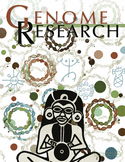DNA methylation and heterochromatinization in the male-specific region of the primitive Y chromosome of papaya
- 1 Department of Horticulture, University of Wisconsin, Madison, Wisconsin 53706, USA;
- 2 State Key Laboratory of Crop Genetics and Germplasm Enhancement, Nanjing Agricultural University, Nanjing, Jiangsu 210095, People’s Republic of China;
- 3 Hawaii Agriculture Research Center, Aiea, Hawaii 96701, USA;
- 4 Department of Plant Biology, University of Illinois at Urbana–Champaign, Urbana, Illinois 61801, USA
-
↵5 These authors contributed equally to this work.
Abstract
Sex chromosomes evolved from autosomes. Recombination suppression in the sex-determining region and accumulation of deleterious mutations lead to degeneration of the Y chromosomes in many species with heteromorphic X/Y chromosomes. However, how the recombination suppressed domain expands from the sex-determining locus to the entire Y chromosome remains elusive. The Y chromosome of papaya (Carica papaya) diverged from the X chromosome approximately 2–3 million years ago and represents one of the most recently emerged Y chromosomes. Here, we report that the male-specific region of the Y chromosome (MSY) spans ∼13% of the papaya Y chromosome. Interestingly, the centromere of the Y chromosome is embedded in the MSY. The centromeric domain within the MSY has accumulated significantly more DNA than the corresponding X chromosomal domain, which leads to abnormal chromosome pairing. We observed four knob-like heterochromatin structures specific to the MSY. Fluorescence in situ hybridization and immunofluorescence assay revealed that the DNA sequences associated with the heterochromatic knobs are highly divergent and heavily methylated compared with the sequences in the corresponding X chromosomal domains. These results suggest that DNA methylation and heterochromatinization play an important role in the early stage of sex chromosome evolution.
Footnotes
-
↵6 Corresponding author.
↵6 E-mail jjiang1{at}wisc.edu; fax (608) 262-4743.
-
[Supplemental material is available online at www.genome.org.]
-
Article published online before print. Article and publication date are at http://www.genome.org/cgi/doi/10.1101/gr.078808.108.
-
- Received March 24, 2008.
- Accepted June 17, 2008.
- Copyright © 2008, Cold Spring Harbor Laboratory Press











